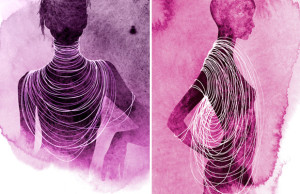
And yet the sex negativity that Gayle Rubin describes is not absent from Jewish cultural views about sex. It can be partially attributed to the patriarchal structure that has dominated Jewish legal decisions and continues to in most observant communities, and partially attributed to the internalized Christian sexual ethic that has blended with the Jewish sexual ethic over time. Men still largely control the productive capacity of Torah knowledge and the power to legislate over the body, but that is slowly changing with the advent of institutions advocating for Orthodox feminism, Orthodox female rabbis, and female legal decisions in areas of law that pertain to women’s bodies.
An important distinction must be made, however, between the reality in which observant Judaism has found itself, and what Judaism actually has to say about bodies and spheres of meaning. Winkler explains that it is true, religious law often favors men, but that has much more to do with patriarchal societal structures from ancient times than it does with what God wants from the world. “What God wills and what mortal male prophets purport to be God’s will are not always the same.” (61) There are dozens of stories in the Pentateuch about how prophets and the Children of Israel got it wrong, and the “discrepancy between God and religion.”
Rabbi Samuel David Luzzatto of 19th century Italy explained that the various social restrictions in the Torah are not religious laws, but are societal laws for the Jews as they were forming a nation. Societal rules are designed to allow for freedoms within an order that maximizes stability, sustainability, and value. (62) Many laws are drastically different than a simple reading of the Pentateuch would indicate – Jews have never prosecuted adulterous women, sentenced rebellious children to death, or literally taken an “eye for an eye.” Those laws were interpreted instead as moral warnings, paradigms of depravity, and incidences requiring monetary compensations, not as true-to-life proscriptions. (63)
Similarly, sexual laws were meant to keep moral and social order, not to limit desire; the Bible that proscribes laws for sexual behavior has no problem liberally discussing the sexual antics of its heroes. Judah goes looking for a prostitute and ends up sleeping with his righteously duplicitous daughter-in-law, who merits to bear the forbearer of King David (64); Jacob marries two sisters who negotiate between themselves for conjugal rights (65); Ruth climbs into the bed of a man she wishes to marry as he lay asleep on the threshing room floor (66); and the Song of Songs is considered to be one of the most erotic love poems of all time. The Rabbis throughout the centuries have wrestled to find alternate meanings to these examples and more, but it does not change the explicit and open nature of their telling. (67)
The standard yeshiva day school graduate might not know it, but the Talmud is filled with sex. The Rabbis were all doing it with their wives, and often with prostitutes. Sometimes the sex and its discussion is problematic, sometimes it is lauded. Lust is extolled, celebrated, downplayed, and rebuked. But regardless, it is recognized as “essential to human welfare and as a powerful gift from God that is to be harnessed not with shackles but with responsibility.” (68)
The landscape continues to shift in the Modern Orthodox world. On the one hand you have the Orthodox Union and the National Council of Synagogue Youth (a governing body of American Orthodox Judaism and the related national youth group organization that it runs) publishing a website called www.negiah.org which teaches that any male-female sexual interaction out side of marriage will have horrific consequences. Sexual activity (to any extent) before marriage will leave young people (especially women) depressed, drug-addicted, infected with an STI, potentially pregnant, and spiritually ruined. (69)
On the other hand, you have incidents like The Beacon “scandal” that inspire reserved hopes. Yeshiva University is a Modern Orthodox institution located in Manhattan. It hosts its men’s campus in Washington Heights and and its women’s campus, called Stern College, in Midtown. The campuses are separated by 200 blocks, a theoretically effective prophylaxis against impropriety. When the YU student publication, The Beacon, published an anonymous article in 2011 about the sexual experience of two students in a hotel room, there was widespread outrage, delight, and engaged debate in the Modern Orthodox world about what such an article meant for the changing values and realities of the wider community. (70)
The Beacon eventually broke ties with the University so that there would be no conflicts of interest between financial support and intellectual honesty. The Beacon’s editor, Simi Lampert, went on to author an article in the Jewish Daily Forward about the controversy. She explained that the goal of the publication was to “foster a platform where Yeshiva students could talk about what was really on their minds.” She fully stands up for the decision to publish the article and break ties with the university, citing her belief not only for free speech, but for the need to speak. “If we can’t speak about issues like premarital sex, how will anyone make safe and smart decisions?” She theorizes that the story “How Do I Even Begin to Explain This,” sparked such controversy because of its directness. “The author speaks with candor and emotion. It’s not a theoretical discussion of the existence of sex in the Orthodox community at large; it’s real, it’s raw and it’s right here in our own school. This is too honest to ignore.” (71)
You may also like...
-

[button link="https://jewrotica.org/tag/pg/" color="#ff0066" size="3" style="1" dark="0" radius="auto" target="self"]PG[/button] [button link="https://jewrotica.org/tag/pg-13/" color="#ff0066" size="3" style="1" dark="0" radius="auto" target="self"]PG-13[/button] [button link="https://jewrotica.org/tag/rated-r/" color="#ff0066" size="3" style="1" dark="0" radius="auto" target="self"]R[/button] [button link="https://jewrotica.org/tag/xxx/" color="#ff0066" size="3" style="1" dark="0" radius="auto" target="self"]XXX[/button]




Like Us!
-
-
 jewrotica | February 18, 2023
jewrotica | February 18, 2023
Celebrating 10 Years & Marking the End of An Amazing Project
-
 jewrotica | November 23, 2016
jewrotica | November 23, 2016
-
 jewrotica | February 14, 2015
jewrotica | February 14, 2015
-
 sarah | February 28, 2013
sarah | February 28, 2013
-
 Karalyn | February 27, 2013
Karalyn | February 27, 2013
-
 Hugo Schwyzer | November 13, 2012
Hugo Schwyzer | November 13, 2012
-
 jewrotica | February 18, 2023
jewrotica | February 18, 2023
Celebrating 10 Years & Marking the End of An Amazing Project
-
 jewrotica | November 23, 2016
jewrotica | November 23, 2016
-
 jewrotica | February 14, 2015
jewrotica | February 14, 2015
-
 Arturo Desimone | May 2, 2019
Arturo Desimone | May 2, 2019
-
 Joseph Dunsay | May 1, 2019
Joseph Dunsay | May 1, 2019
-
Testimonials
While many people fear the “sex talk,” Jewrotica offers an opportunity for writers and audiences to speak about sexuality in a open and safe space. When I attended a Jewrotica reading, I heard stories that reminded me that love takes many forms, and that expressing it is a vital part of who we are as a people.
Leora, Young Professional from Washington DCJewrotica is awesome. It expands the mind and for people who were raised with narrow views on sexuality. Whether you are Jewish or not, or in different sects of Judaism like Orthodox, Conservative or Reform, no matter what your background or where you’re from, Jewrotica gets you to see Judaism and how it relates to sexuality in new ways. I really appreciate Ayo being here and helping us learn different ways to connect with our sexuality.
Vanessa Steiner, Young Professional in Southern CaliforniaAt Jewrotica’s Evening of Bedside Readings, students declaimed monologues on sexual encounters that had a Jewish twist. At Columbia/Barnard Hillel, the speakers pushed their own boundaries by performing a range of explicit narratives that challenged how the audience thought of the relationship to Judaism and sex. During the speakers’ preparation, the arguments about which narratives would be appropriate forced students to take a stand and voice their opinion on their own beliefs about Judaism an… Read more
Engagement Coordinator at Columbia University / Barnard HillelJewrotica was everything I had dreamed of and more: sexy attendees, tantalizing confessions, and well-written literature to boot! More importantly, it empowers us Jews to reach inside and own our sexy selves and heritage!
Erin L., University of Texas at Austin Social Work Graduate StudentJewrotica is something that the community has needed for a long time so that people can actually learn, express and share and have good relationships without having to stumble through life. Check out the site and learn something. Have fun!
Josh Kaplan, Jewish Community Organizer in Orange County, CAWhat an incredible night Jewrotica was!!!! There was this fantastic moment, in a sea of Jews of all sexualities, ages, backgrounds and denominations, that I realized we were all in this together! I hope that there are many more events coming to Austin soon!
Brandon Poland, Award-Winning Jewish Drag QueenI stepped out of my comfort zone to be a part of this. I was glad to open up the topic of sexuality in my community. We are trying to build a safe space to talk about sex. The result I am most happy about coming from this event is that hopefully now my friends know they can come and talk to me, that I can be their ‘safe space’.
Barnard College Student, Presenter at the Columbia University Kickoff EventLearning about sex and what’s right and wrong when it comes to sex from a Biblical standpoint was an eye opening experience. I completely enjoyed it and think something like this could be a very cool thing to bring to even high school aged Jewish youth groups.
Hannah S., A Student at SUNY PurchaseBedside Reading with Jewrotica was funny, sexy, and hot all at once. The readings were honest about all kinds of sexuality, but the highlight of the evening was definitely the confessions, written by audience participants. Nobody knew who wrote them, and most were tell-alls that would make your bubbe blush. Unless your bubbe was very, very cool. Then maybe she’d make YOU blush!
Dan Young, Architect from Flagstaff AZ and Jewish Community Leader in Austin TXI’m into Jewrotica. I went in for my second circumcision.
Josh Karp, Artist and Staff at JewliciousDear Jewrotica
Confess
Copyright © 2014 Jewrotica.org. All Rights Reserved.
Built with Love and Mischief.
Designed by Ayo Oppenheimer and
David Abitbol





0 comments